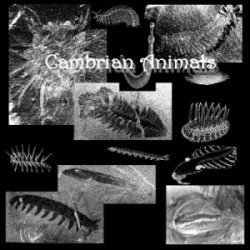 Cambrian Period In Texas
Cambrian Period In TexasTexas laid under a shallow sea during the Cambrian Period. Land lying to the northwest contained sediments comprising of mostly sands that were carried into the sea. Other sediments, such as limestones and dolostones were deposited further out to sea. Those rocks, not visible on the map above, are found in the Llano Uplift area of Texas. Fossils of sponges, gastropods, trilobites, bivalves and bryozoans are found within those deposits.
 |
| North American Continent during the Cambrian Period showing most of Texas under a shallow sea |
Gastropods are a large group of molluscs. Most have a coiled or conical shell, a muscular foot, eyes, tentacles and a feeding organ or radula. They first appeared in the Cambrian period and colonised all marine habitats. Some lived on the seabed, others burrowed into the mud or sand or attached themselves to rocks.
Trilobites are an extinct group of animals that lived in the worlds oceans millions of years ago. They get their name from the way that their bodies are divided into three sections. Most trilobites are thought to have scavenged for food either under, or on the surface of the sediment of the sea floor although some would have been able to swim. They ranged in size from just one mm to about one metre in length.
These bryozoans are also known as moss-animals and are filter feeders. Mineralized skeletons of bryozoans appear in rocks from Early Ordovician period, about 480 million years ago, while all other fossilized phyla appear in earlier periods. This has led researchers to suspect that bryozoans had arisen earlier but were initially unmineralized, and may have differed significantly from fossilized and modern forms.
Cambrian Explosion
Most major animal groups appear for the first time in the fossil record some 545 million years ago on the geological time scale in a relatively short period of time known as the Cambrian explosion. Of great worry to Darwin, the explanation of this sudden, apparent explosion persists as a sources of numerous major debates in paleobiology. While some scientists believe there was indeed an explosion of diversity (the so-called punctuated equilibrium theory elaborated by Nils Eldredge the late Stephen J. Gould - Models In Paleobiology, 1972, others believe that such rapid acceleration of evolution is not possible; they posit that there was an extended period of evolutionary progression of all the animal groups, the evidence for which is lost in the all but nonexistent precambrian fossil record. Modern molecular technologies (genomics and other omics), through comparing nucleic acid and amino acid sequences across living species, are enabling the identification of genetic components and patterns stingily conserved by evolution, from which times of evolutionary branching of the tree of life can be inferred.
 appeared in the Cambrian only to rapidly disappear. Natural selection is generally believed to have favored larger size, and consequently the need for hard skeletons to provide structural support - hence, the Cambrian gave rise to the first shelled animals and animals with exoskeletons (e.g., the trilobites). The early Cambrian and the size of many animals also "exploded".
appeared in the Cambrian only to rapidly disappear. Natural selection is generally believed to have favored larger size, and consequently the need for hard skeletons to provide structural support - hence, the Cambrian gave rise to the first shelled animals and animals with exoskeletons (e.g., the trilobites). The early Cambrian and the size of many animals also "exploded".The Cambrian Explosion is the outcome of changes in environmental factors leading to changes in selective pressures in turn leading to adaptive diversification on a vast scale. By the start of the Cambrian, the large supercontinent Gondwana, comprising all land on Earth, was breaking up into smaller land masses. This increased the area of continental shelf, produced shallow seas, and expanded diversity of environmental niches in which animals could specialize and speciate.
The debate persists today about whether the evolutionary "explosion" of the Cambrian was as sudden and spontaneous as it appears in the fossil record. The discovery of new pre-Cambrian and Cambrian fossils help, as these transitional forms support the hypothesis that diversification was well underway before the Cambrian began. More recently, the sequencing of the genomes of thousands of life forms is revealing just how many and what genes and the proteins they encode have been conserved from the Precambrian. The explosion of external form in the fossil record is what we see, but more gradual adaptation was taking place at the molecular level. Wang et. al. (1999) for example, recently conducted phylogenetic studies divergences among animal phyla, plants, animals and fungi. These researchers estimated Arthropods diverged from more primitive chordates more than 900 million years ago, and Nematodes from that lineage almost 1200 million years ago. They furthermore estimated that the plant, animal and fungi Kingdoms might have split almost 1600 million years ago. Finally, they conjecture that the basal animal phyla (Porifera, Cnidaria, Ctenophora) diverged between about 1200 and 1500 million years ago. If their research is valid, at least six major metazoan phyla appeared deep in the Precambrian, hundreds of millions of years before the oldest fossils in the fossil record.
For more information:
http://www.paleoportal.org/index.php?globalnav=time_space§ionnav=state&name=texas
http://ediacaran.blogspot.com/2010/10/evolution-among-trilobites-part-2.html
http://www.shropshire.gov.uk/legacy/llmrc.nsf/open-exhib/Poleumita%20discors%20%284%29
http://tapestry.usgs.gov/ages/ages.html








